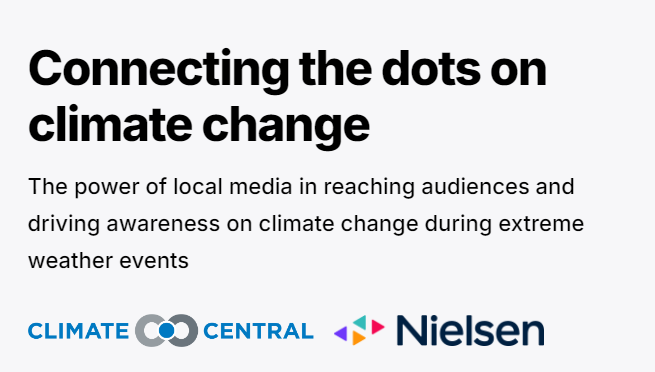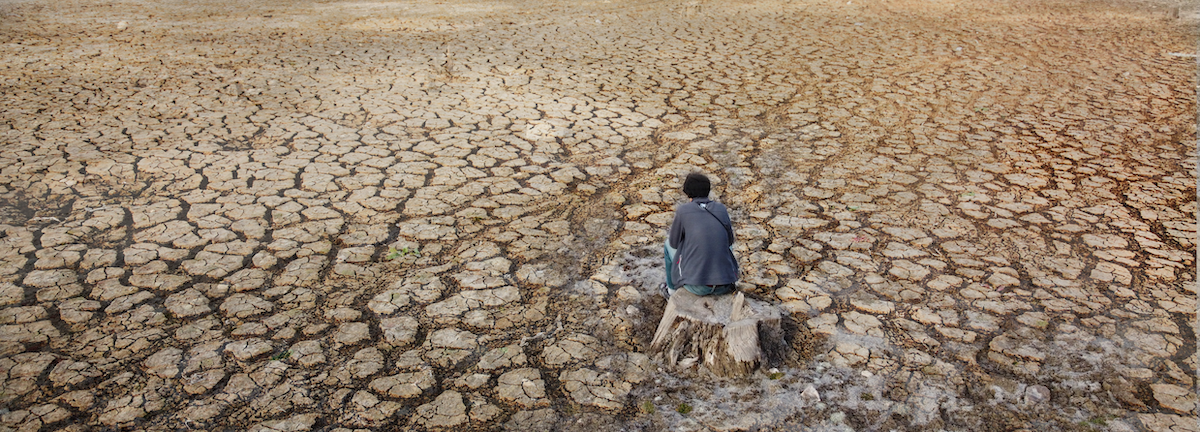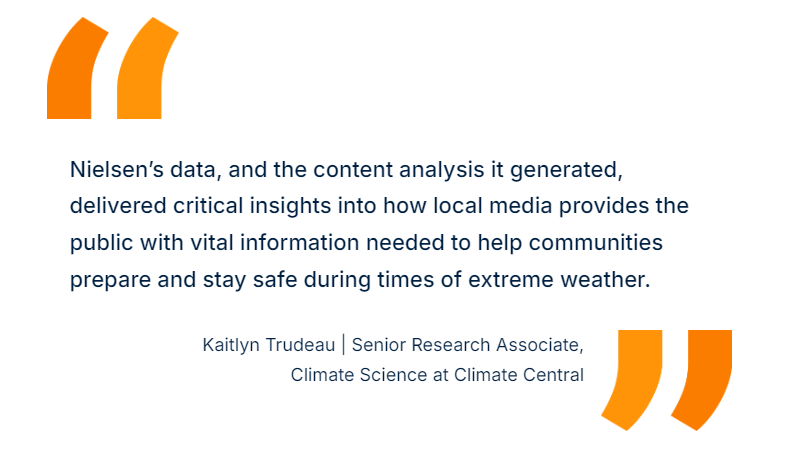Nielsen and Climate Central: Connecting the Dots on Climate Change
The power of local media in reaching audiences and driving awareness on climate change during extreme weather events
Originally published on Nielsen Insights
Introduction: Understanding local media’s reach during extreme weather events
Nielsen collaborated with Climate Central, a policy-neutral non-profit climate science organization, to assess the presence of accurate and informative climate reporting in local media to engage communities affected by extreme weather events.
Objective: Highlight local media’s role in driving climate change awareness
According to the American Meteorological Society, local weather broadcasting is extremely effective in raising awareness about climate change. Climate Central collaborated with Nielsen to analyze local TV newscasts for climate change content and measure the audience reach associated with those broadcasts.
Challenge: Engaging local media stations to educate audiences about climate change
Despite increasing public concern about the link between climate change and extreme weather, only 28% of people in the U.S. say they hear about global warming in the media at least once a week. This suggests that media, including local media, frequently misses opportunities to increase public understanding and awareness of extreme weather and climate change.
Solution: Create a climate content metric for reports using audience reach and context analysis
Using Nielsen Local TV View (NLTV), Nielsen Grabix and the PPM Analysis Tool, Nielsen analyzed local television news and radio coverage in the top 50 U.S. DMAs related to four extreme weather events from 2022-2023 that could appropriately be connected with climate change. These events were Hurricane Ian, the Canadian wildfires, the Phoenix heat streak and Tropical Storm Hilary. The data was used to understand if, when and how coverage discussed the event in the context of climate change and was turned into a public report detailing viewership and content analysis of local TV news segments during those four notable extreme weather events.
Key findings:
17M total reach: Broadcast segments during extreme weather events have high reach and impact. Nationwide, over 17 million people in the Top 50 DMAs were exposed to segments connecting the extreme weather event to climate change.
48% understand segments: Extreme heat was most often connected to climate change. About 48% of all climate contextualized segments were about the Phoenix heat streak of 31 days of >110℉ temperatures.
395% increased reach: During Hurricane Ian, the average reach for local news streaming apps in Orlando among people ages 25-54 increased 395% over the previous week. Local TV viewership also had exponential increases, doubling in the Orlando market for Hurricane Ian and in Los Angeles for Tropical Storm Hilary.
Results: The Climate Content Analysis proved the value and opportunity of climate reporting
This collaboration resulted in a climate content analysis used to assess the presence of climate contextualization in local TV coverage of extreme weather, meeting the public’s growing appetite for accurate information on the causes and impacts of extreme weather.
Conclusion: Nielsen’s content analysis unlocks local media programming insights during extreme weather events
Nielsen’s audience and content analysis tools powered the creation of a new metric that sets the standard for assessing climate reporting in media. This metric identifies where local media stations can provide clear weather reporting to increase awareness about climate change and its links to extreme weather events.
Nielsen’s data, and the content analysis it generated, delivered critical insights into how local media provides the public with vital information needed to help communities prepare and stay safe during times of extreme weather.
Kaitlyn Trudeau | Senior Research Associate, Climate Science at Climate Central
Visit Nielsen's site to learn more and connect with their team of experts.





